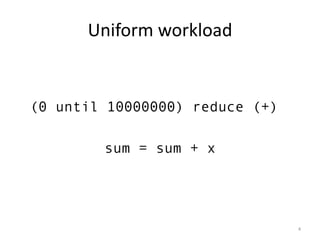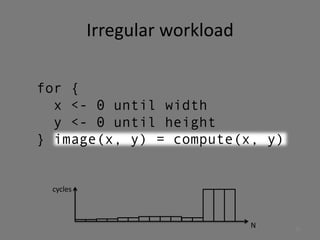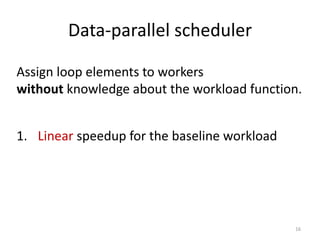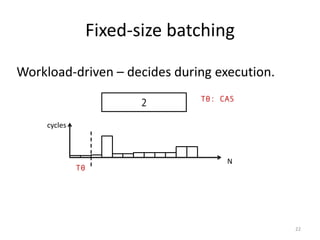Work-stealing Tree Data Structure
- 1. Near Optimal Work-Stealing Tree for Highly Irregular Data-Parallel Workloads Aleksandar Prokopec Martin Odersky 1
- 2. Near Optimal Work-Stealing Tree for Highly Irregular Data-Parallel Workloads Aleksandar Prokopec Martin Odersky 2
- 3. Uniform workload (0 until 10000000) reduce (+) 3
- 4. Uniform workload (0 until 10000000) reduce (+) sum = sum + x 4
- 5. Uniform workload (0 until 10000000) reduce (+) sum = sum + x … N cycles 5
- 6. Baseline workload for (0 until 10000000) {} … N cycles 6
- 8. Irregular workload N cycles 8
- 9. Irregular workload for { x <- 0 until width y <- 0 until height } image(x, y) = compute(x, y) N cycles 9
- 10. Irregular workload for { x <- 0 until width y <- 0 until height } image(x, y) = compute(x, y) N cycles 10
- 11. Workload function workload(n) – work spent on element n after the data-parallel operation completed 11
- 12. Workload function Could be… Runtime value dependent for { x <- 0 until width y <- 0 until height } img(x, y) = compute(x, y) workload(n) – work spent on element n after the data-parallel operation completed 12
- 13. Workload function Could be… Execution-schedule dependent for (n <- nodes) n.neighbours += new Node workload(n) – work spent on element n after the data-parallel operation completed 13
- 14. Workload function Could be… Totally random for ((x, y) <- img.indices) img(x, y) = sample( x + random(), y + random() ) workload(n) – work spent on element n after the data-parallel operation completed 14
- 15. Data-parallel scheduler Assign loop elements to workers without knowledge about the workload function. 15
- 16. Data-parallel scheduler 1. Linear speedup for the baseline workload Assign loop elements to workers without knowledge about the workload function. 16
- 17. Data-parallel scheduler 1. Linear speedup for the baseline workload 2. Optimal speedup for irregular workloads Assign loop elements to workers without knowledge about the workload function. 17
- 18. Static batching Decides on the worker-element assignment before the data-parallel operation begins. N cycles 18
- 19. Static batching Decides on the worker-element assignment before the data-parallel operation begins. No knowledge → divide uniformly. Not optimal for even mildly irregular workloads. N cycles 19
- 20. Fixed-size batching Workload-driven – decides during execution. N cycles progress 20
- 21. Fixed-size batching Workload-driven – decides during execution. N cycles 0 21
- 22. Fixed-size batching Workload-driven – decides during execution. N cycles 2 T0: CAS T0 22
- 23. Fixed-size batching Workload-driven – decides during execution. N cycles 4 T1: CAS T0 T1 23
- 24. Fixed-size batching Workload-driven – decides during execution. N cycles 6 T0: CAS T0 T1 24
- 25. Fixed-size batching Workload-driven – decides during execution. N cycles 8 T0: CAS T0 T1 25
- 26. Fixed-size batching Workload-driven – decides during execution. N cycles 10 T0: CAS T0 T1 26
- 27. Fixed-size batching Workload-driven – decides during execution. N cycles 12 T0: CAS T0 T1 27
- 28. Fixed-size batching Workload-driven – decides during execution. N cycles progress Pros: lightweight Cons: minimum batch size, contention 28
- 29. Fixed-size batching - contention 29
- 30. Factoring, GSS, TS Batch size varies. N cycles progress Pros: lightweight Cons: contention 30
- 31. Task-based work-stealing N cycles 0..2 2..4 4..8 8..16 31
- 32. Task-based work-stealing N cycles 0..2 2..4 4..8 8..16 2..4 4..8 8..16 T0 T1 0..2 32
- 33. Task-based work-stealing N cycles 0..2 2..4 4..8 8..16 2..4 4..8 8..16 T0 T1 0..2 steal – a rare event 33
- 34. Task-based work-stealing N cycles 0..2 2..4 4..8 8..16 2..4 4..8 8..16 T0 T1 10..12 12..16 8..10 0..2 34
- 35. Task-based work-stealing Pros: can be adaptive - uses stealing information Cons: heavyweight - minimum batch size much larger N cycles 0..2 2..4 4..8 8..16 2..4 4..8 8..16 T0 T1 10..12 12..16 0..2 8..10 35
- 36. Task-based work-stealing N cycles 0..2 2..4 4..8 8..16 Cannot be stolen after T0 starts processing it 36
- 37. Work-stealing tree 0 0 T0 N owned 37
- 38. Work-stealing tree 0 0 T0 N 0 50 T0 N owned owned T0: CAS 38
- 39. Work-stealing tree 0 0 T0 N 0 50 T0 N 0 N T0 N … owned owned completed T0: CAS T0: CAS What about stealing? 39
- 40. Work-stealing tree 0 0 T0 N 0 50 T0 N 0 N T0 N … owned owned completed 0 -51 T0 N T0: CAS T1: CAS stolen T0: CAS 40
- 41. Work-stealing tree 0 50 T0 N 0 N T0 N … owned completed 0 -51 T0 N T0: CAS stolen T0: CAS 0 0 T0 N owned T1: CAS 41
- 42. Work-stealing tree 0 50 T0 N 0 N T0 N … owned completed 0 -51 T0 N T0: CAS stolen 0 -51 T0 N expanded 50 50 T0 M M M T1 N T0: CAS 0 0 T0 N owned M = (50 + N) / 2 42
- 43. Work-stealing tree 0 50 T0 N 0 N T0 N … owned completed 0 -51 T0 N T0: CAS stolen 0 -51 T0 N expanded 50 50 T0 M M M T1 N T0: CAS 0 0 T0 N owned M = (50 + N) / 2 T0 or T1: CAS 43
- 44. Work-stealing tree 0 50 T0 N 0 N T0 N … owned completed 0 -51 T0 N T0: CAS stolen 0 -51 T0 N expanded 50 50 T0 M M M T1 N T0 or T1: CAS T0: CAS 0 0 T0 N owned M = (50 + N) / 2 44
- 45. Work-stealing tree - contention 45
- 46. Work-stealing tree scheduling 1)find either a non-expanded, non-completed node 2)if not found, terminate 3)if not owned, steal and/or expand, and descend 4)advance until node is completed or stolen 5)go to 1) 50
- 47. Work-stealing tree scheduling 2)if not found, terminate 3)if not owned, steal and/or expand, and descend 4)advance until node is completed or stolen 5)go to 1) 1)find either a non-expanded, non-completed node 51
- 48. Choosing the node to steal Find first, in-order traversal 2 9 5 3 52
- 49. Choosing the node to steal Find first, in-order traversal 2 9 5 3 Catastrophic – a lot of stealing, huge trees 53
- 50. Choosing the node to steal Find first, in-order traversal Find first, random order traversal 2 9 5 3 2 9 5 3 Catastrophic – a lot of stealing, huge trees 54
- 51. Choosing the node to steal Find first, in-order traversal Find first, random order traversal 2 9 5 3 2 9 5 3 Catastrophic – a lot of stealing, huge trees Works reasonably well. 55
- 52. Choosing the node to steal Find first, in-order traversal Find first, random order traversal Find most elements 2 9 5 3 2 9 5 3 2 9 5 3 Catastrophic – a lot of stealing, huge trees Works reasonably well. Generates least nodes. Seems to be best. 56
- 53. Comparison with fixed-size batching 57
- 54. Comparison with fixed-size batching 58
- 55. Comparison with task work-stealing 59
- 56. Thank you! Questions? 60
- 57. Finding work 61


























































